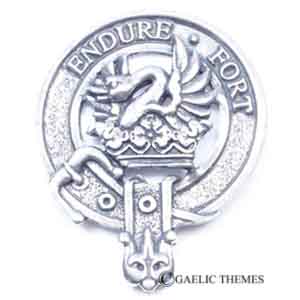Lindsay
Select
- Clan Motto: Endure Fort (“Endure Boldly”)
- Notes:
Crest: Issuing from an antique ducal coronet Or, the head, neck and wings of a swan Proper
‘Lindissie’ translates as Lincoln’s Island and was a jurisdiction in that English shire. Sir Walter de Lindissie ‘noble and knight’, accompanied David, Earl of Huntingdon, to Scotland to claim his throne. Sir Walter’s great-grandson, Sir William de Lindesay, sat in the 1164 Parliament and held the lands of Crawford, which became the earldom of the Chiefs. William married wealth; namely Ethelreda, granddaughter of the great Cospatrick ruler of Northumbria.
Years later in 1390, Sir David de Lindsay won fame and fortune when he won King Richard II’s famous tournament at London Bridge. In 1398, he was created Earl of Crawford. David went on to become Lord High Admiral of Scotland in 1403 and served as ambassador to England in 1406.
The fourth earl, Alexander, joined the rebellion against James II and fought in the battle of Brechin in 1452. However, the Royals won and Alexander was arrested for treason, later pardoned. The fifth earl was also a Lord High Admiral of Scotland, Master of the Royal Household, Lord Chamberlain and High Justiciary. The sixth earl fell at the battle of Flodden while in attendance on King James IV.
During the Civil War Ludovic Lindsay, an accomplished soldier with continental experience, fought for Charles I. He commanded a regiment of cavalry as Marton Moor and was also at Philiphaugh alongside Montrose in 1645, where he was captured.
Since Ludovic died childless, the successor was of another branch; John, Earl of Lindsay. The title remained with John’s branch until the nineteenth century when it passed to the Lindsays of Balcarres (descendants of a younger son of the ninth earl of Crawford).
The Balcarres had been made earls in their own right thanks to their service during the Civil War. The first Earl Balcarres was made hereditary governor of Edinburgh Castle, Secretary of State for Scotland and High Commissioner to the General Assembly. His son, an ardent Jacobite, fought in the Rising of 1715.
The sixth Earl of Balcarres became the twenty-third Earl of Crawford. His descendant is the twenty-ninth Earl and present Chief.
The Lindsays of Edzell descended from the son of the ninth Earl of Crawford. Edzell Castle north of Brechin is famed for its elaborate renaissance gardens, including walls sculpted to resemble the family coat of arms. Though today the rest of the castle is a ruin, the gardens have been restored.
The seat of the present chief, Lord Crawford, is at Balcarres in Fife. A Knight of the Most Ancient and Most Noble Order of the Thistle, he was a prominent national and local politician before retiring. The earldom of Lindsay has also been revived. The surname is now compounded as Lindsay-Bethune.
